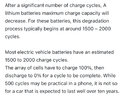Interesting… what are your thoughts on this?
Do Electric Car (EV) Batteries Degrade Over Time? - Midtronics
Well, not the best description. Very shorted and might lead to wrong conclusions.
The Degradation do not begin at 1500-2000 cycles. It begins quite short after delivery.
A Tesla Panasonic NCA might hold up 500 to 700 or maybe 1000 or so cycles if charged to 100% and discharged to 0% each time.
But it will do much more cycles if we use smaller cycles. And if we use small cycles at low SOC, they probably could last very very long.
The article do not mention calendar aging.
Calendar aging is larger than cyclic for most people to a factor of 5-10.
In short, the miles driven is just a small part of the degradation.
Sadly, I don't have a charger at home. So I can only charge at work or use superchargers. But when using Supercharger. I only charge 10-20% not a full charge. I'm trying to keep the battery mostly at 50-55% and sometimes charge it when it's at 20%.
When do you think i should do a full 100% charge? I haven't done that yet. The car is like 3 weeks old almost. I'm thinking soon I may. Maybe start tomorrow? Since I'll be away from work and charger? Also what is the best way to track the degradation any free tools?
Thanks soo much for all your input! @AAKEE
There isnt really a ”need” for a full charge, the battery itself do not need that.
But you shouldnt be afraid of full charges.
In my 17 months of Tesla owning and 40K km i have about one full charge per month I think or slightly more.
Full charges every now and then do not cause very much wear. My charging schedule cause so little degradation that despite some 100% charges I will have much less degradation than the average car anyway. I probably have about five of the full charges that was ”just for fun” and not really needed.
—> I do not think you should be arfraid of full charges. Doing one full charge a week and driving the car down to zero, it will take you ten years to kill the battery from this. (Calendar aging might kill it before though).
I did a 0% to 100% charge today (0.40% SOC, was the real BMS number.) The charging hadnt really stopped but I didnt have the time to stay to see the full charge.
After 41.000km and 1.5 years it still holds 79kWh. If I use 82 kWh as the origin number, I have about 3.5% degradation now.
If I look at the range, I have lost 1.8%.
The 3.5% loss is not a random number, its close to my own calculation. Degradation is predictable!



